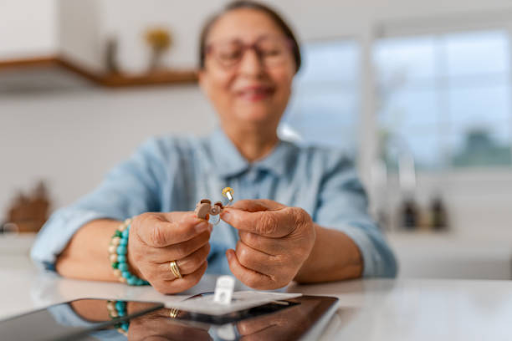Staying Connected with Battery Monitoring and Alerts for Hearing Aids

Hearing aids are tools designed to help those with hearing loss restore clarity and connection in their daily lives. However, their effectiveness hinges on one crucial element: battery power. Without sufficient power, even the most advanced hearing aids can’t perform their essential functions. Ensuring your hearing aids are always powered and ready to go is key to maintaining their reliability and, ultimately, your quality of life.
Understanding Battery Types
There are two main types of batteries used in hearing aids: disposable and rechargeable. Each type has its benefits, and understanding them can help you choose the best option for your lifestyle.
Disposable batteries are the traditional zinc-air batteries that activate when exposed to air. They typically last anywhere from three days to two weeks, depending on usage. The advantage of disposable batteries is their convenience; just replace them as needed, and you’re good to go.
Rechargeable batteries can last an entire day on a single charge and are often designed to last for several years before needing replacement. They’re a great option if you prefer not to worry about carrying spare batteries or changing them frequently.
Battery Monitoring Basics
Most modern hearing aids come equipped with battery monitoring systems that provide real-time updates on battery life. Many hearing aids have visual or auditory indicators that alert you when the battery is running low. These can include beeps, voice notifications, or LED lights that change color. Keeping an eye on these alerts can help you manage your battery usage effectively.
Also, some hearing aids are compatible with smartphone apps that provide detailed battery information. These apps can tell you exactly how much battery life is left and may even offer reminders to charge or replace your batteries. This is especially useful for rechargeable models, as you can monitor the charging progress and ensure they’re fully powered before you start your day.
Knowing how much power your hearing aids have left can prevent unexpected outages, ensuring you’re never caught off guard during important moments. Using these monitoring tools ensures that your hearing aids are always ready when you need them.
The Role of Alerts in Battery Management
These alerts are designed to give you ample time to replace or recharge your batteries, preventing sudden power loss during critical times. Low battery alerts are typically the first line of defense against a battery outage. When you hear or see a low battery alert, it’s a sign that you should start thinking about replacing or recharging your batteries soon. Some hearing aids offer a second alert when the battery is close to completely draining. This alert is often more urgent, signaling that you should act immediately to maintain your hearing aid’s performance.
For those using hearing aids with smartphone integration, smart alerts can notify you on your phone, even if you’re not wearing your hearing aids at the time. This feature ensures you’re always aware of your battery status, no matter where you are. These alerts help you stay proactive, reducing the risk of being left without your hearing aids when you need them most.
How to Extend Battery Life
To extend battery life, always turn off your hearing aids when you’re not using them. This simple habit is important for disposable batteries. Keep your hearing aids in a cool, dry place when not in use because extreme temperatures can drain battery life more quickly. For disposable batteries, opening the battery door when not in use can help reduce power drain by allowing the battery to deactivate. If you use rechargeable hearing aids, make it a habit to charge them every night. This ensures they’re fully powered and ready to go each morning.
Incorporating Smart Battery Management
With technological advancements, smart battery management systems have become more common. These systems optimize how batteries charge and discharge, enhancing their lifespan. For example, some smartphones and laptops learn your usage patterns and charge the battery more efficiently based on your habits. Similarly, smart hearing aids can adjust settings automatically to conserve battery life. Embracing these technologies can lead to better battery performance and fewer interruptions.
